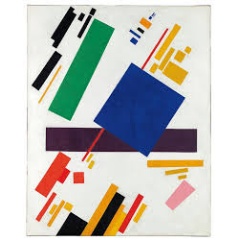Kazimir Malevich’s Revolutionary Suprematist Composition, 1916 to Lead Christie’s Evening Sale of Impressionist and Modern Art

This May, Kazimir Malevich’s Suprematist Composition,1916, will lead Christie’s Evening Sale of Impressionist and Modern Art (estimate upon request). Suprematist Composition is among the groundbreaking abstract paintings executed by Malevich that would forever change the course of art history. The present canvas was last sold at auction in November 2008, when it established the world auction record for the artist, which it continues to hold today.* One decade later, Suprematist Composition is expected to set a new benchmark for the artist when it is offered at Christie’s New York on May 15.
Loic Gouzer, Co-Chairman, Post-War and Contemporary Art, remarked: “Malevich’s work provided a gateway for the evolution of Modernism. Malevich pushed the boundaries of painting to a point far beyond recognition, forever changing the advancement of art. Without the Suprematist Composition paintings, the art being made today would not exist as we now know it.”
Max Carter, Head of Department, Impressionist and Modern Art, New York, continued: “Malevich’s Suprematist abstractions didn’t break with the past so much as articulate the future. What an honor to offer Suprematist Composition, 1916 which has lost nothing of its revolutionary power in the century since it was painted, this spring.”
On 17th December 1915, the Russo-Polish artist Kazimir Malevich opened an exhibition of his new ‘Suprematist’ paintings in the Dobychina Art Bureau in the recently renamed city of Petrograd. These startling, purely geometric and completely abstract paintings were unlike anything Malevich, or any other modern painter, had ever done before. They were both a shock and a revelation to everyone who saw them. Malevich’s Suprematist pictures were the very first purely geometric abstract paintings in the history of modern art. They comprised solely of simple, colored forms that appeared to float and hover over plain white backgrounds. Nothing but clearly-organized, self-asserting painted surfaces of non-objective/non- representational form and color, these pictures were so radically new that they seemed to announce the end of painting and, even perhaps, of art itself.
Suprematist Composition is one of the finest and most complex of these first, truly revolutionary abstract paintings. Comprised of numerous colored, geometric elements seeming to be dynamically caught in motion, it epitomizes what Malevich defined as his ‘supreme’ or ‘Suprematist’ vision of the world. The painting is not known to have been a part of the exhibition in the Dobychina Art Bureau but is believed to date from this same period of creative breakthrough and, if not included, was, presumably painted very soon after the show closed in January 1916.
It is clear, from the frequency with which Malevich later exhibited the picture, that he thought very highly of the painting. Malevich subsequently chose, for example, to include Suprematist Composition in every other major survey of his Suprematist pictures made during his lifetime. These exhibitions ranged from his first major retrospective in Moscow in 1919 to the great travelling retrospective showcasing much of his best work that he brought to the West in 1927. It was as a result of his last exhibition held in Berlin that Suprematist Composition came to form part of the extraordinarily influential group of Malevich’s paintings that remained in the West and represent so much of his creative legacy.
Hidden in Germany throughout much of the 1930’s, Suprematist Composition and the other works from this great Berlin exhibition, were ultimately to become part of the highly influential holdings of Malevich’s work in the Museum of Modern Art in New York and the Stedelijk Museum in Amsterdam. Until 2008, when it was restituted to the heirs of Malevich’s family in agreement with the Stedelijk museum, Suprematist Composition was on view in Amsterdam as part of the Stedelijk’s unrivalled collection of the artist’s work.
--------
The record setting price was achieved by Suprematist Composition, 1916, on November 3, 2008 at Sotheby’s New York, when it sold for $60,002,500.
About Christie’sChristie’s, the world’s leading art business, had global auction, private and digital sales in 2017 that totalled £5.1 billion / $6.6 billion. Christie’s is a name and place that speaks of extraordinary art, unparalleled service and international expertise. Christie’s offers around 350 auctions annually in over 80 categories, including all areas of fine and decorative arts, jewellery, photographs, collectibles, wine, and more. Prices range from $200 to over $100 million. Christie’s also has a long and successful history conducting private sales for its clients in all categories, with emphasis on Post-War & Contemporary, Impressionist & Modern, Old Masters and Jewellery.
Alongside regular sales online, Christie’s has a global presence in 46 countries, with 10 salerooms around the world including in London, New York, Paris, Geneva, Milan, Amsterdam, Dubai, Zürich, Hong Kong, and Shanghai.
*Please note when quoting estimates above that other fees will apply in addition to the hammer price - see Section D of the Conditions of Sale at the back of the sale catalogue.
*Estimates do not include buyer’s premium. Sales totals are hammer price plus buyer’s premium and are reported net of applicable fees.
( Press Release Image: https://photos.webwire.com/prmedia/6/222702/222702-1.jpg )
WebWireID222702
This news content was configured by WebWire editorial staff. Linking is permitted.
News Release Distribution and Press Release Distribution Services Provided by WebWire.